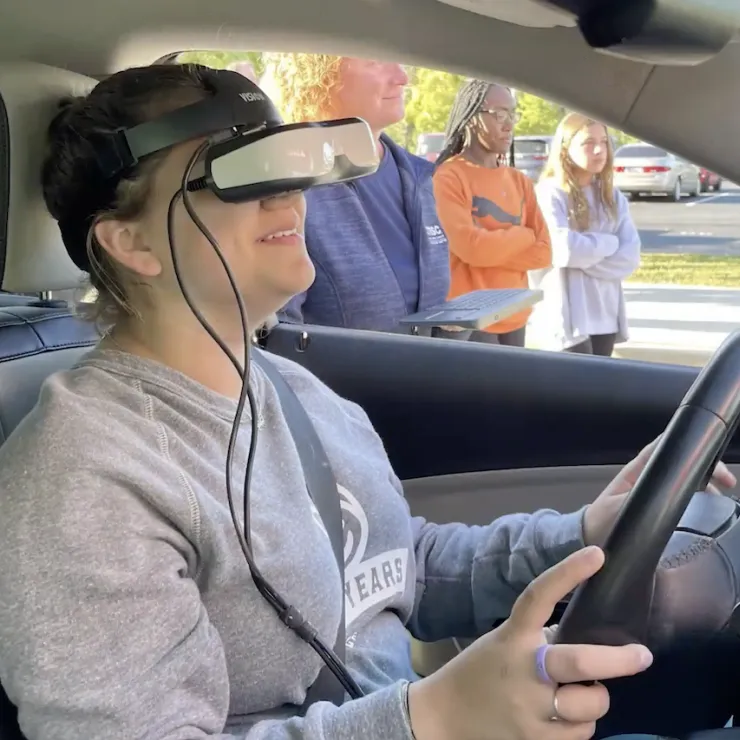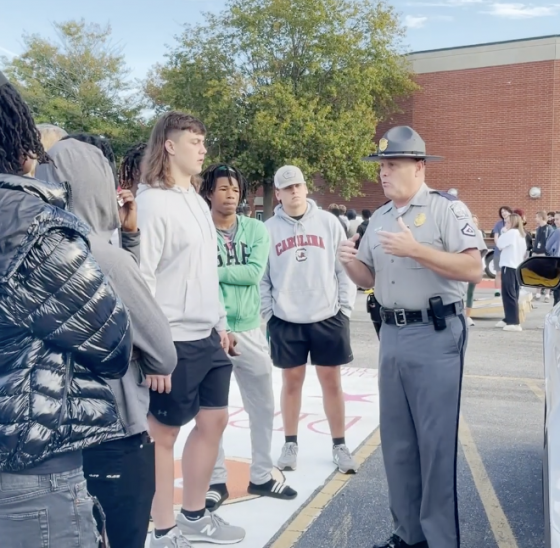Teen Driver Safety Week
This October we're hosting a hands-on tour to remind South Carolina & Georgia teen drivers that distracted driving can be deadly. Join us as we share these lifesaving lessons with local teens and families.

Tips for Parents
Help teens stay safe behind the wheel with these rules, goals and conversation-starters. We're teaming up with U.S. Department of Transportation’s National Highway Traffic Safety Administration (NHTSA) to help empower parents to discuss the importance of driving safety with their young drivers.
- Set Driving Rules
-
- You are a parent first. As such, your job is to protect your teen. Use this motivation to keep your teen safe as they start navigating their new role as a driver.
- Remind your teen that driving is a privilege, not a right. As the parent, you are in control. If they aren’t following the Rules for the Road, they don’t need keys to the car.
- Have a conversation with your teen driver about driving laws and safe driving habits. Your desire to keep them safe will never fade, so make sure to always keep the lines of communication open. Believe it or not, your teen is listening and they depend on you to guide and be there for them.
- Become familiar with your state’s nighttime driving restrictions, passenger restrictions and all the graduated driver licensing (GDL) restrictions. Self-reported surveys show that teens with parents who set and enforce firm rules for driving typically engage in less risky driving behaviors and are involved in fewer crashes. By knowing and enforcing the laws with your teen, you will help promote their safety and the safety of those around them.
- Be a good role model for your teen driver and set an example with your own safe driving habits.
- Talk to your teen about cell phone use while driving. Encourage them to stow their phones, designate a texter or to pull over before answering phone calls, texting or engaging with any social media apps. Remind your teen that it’s not only unacceptable to post on social media while driving but illegal.
- Know the Facts
-
- Motor vehicle crashes are a leading cause of death for teens (15-18 years old) in the United States.
- In 2019, there were 2,042 people killed in crashes involving a teen passenger vehicle driver (15-18 years old); 628 of the deaths were the teen passenger vehicle driver.
- Parents: You can be the biggest influence on your teen’s choices when they are behind the wheel. Take the time to have a conversation with them about some of the biggest driving risks for teens, including:
- Impaired Driving: All teens are too young to legally buy, possess, or consume alcohol. However, nationally, in 2019, 16% of teen passenger vehicle drivers involved in fatal crashes had alcohol in their system. Alcohol isn’t the only substance that can keep your teen from driving safely: marijuana affects a driver’s ability to react to their surroundings. Driving is a complex task and marijuana slows the reaction time. Remind your teen that driving under the influence of any impairing substance—including illicit or prescription drugs, or over-the-counter medication—could have deadly consequences. It is critical that teen drivers understand why they shouldn’t drive impaired—strict penalties may apply, such as losing their license or facing additional consequences for breaking rules they agreed to follow when they started driving.
- Seat Belts: Wearing a seat belt is one of the simplest ways for everyone to stay safe in a vehicle. Yet too many teens aren’t buckling up. In 2019, 45% of the teen passenger vehicle drivers who died in crashes were unbuckled. Even more troubling, when the teen driver involved in the fatal crash was unbuckled, nine out of 10 of the passengers who died were also unbuckled.
- Distracted Driving: Distractions while driving are more than just risky—they can be deadly. In 2019, among teen passenger vehicle drivers involved in fatal crashes, 10% were reported as distracted at the time of the crash.
- Speeding: In 2019, more than one-quarter (27%) of all teen drivers of passenger vehicles involved in fatal crashes were speeding at the time of the crash. Males were more likely to be involved in fatal crashes than females.
- Passengers: Teen drivers transporting passengers can lead to disastrous consequences. Research shows that the risk of a fatal crash dramatically increases in direct relation to the number of passengers in a vehicle. The likelihood of teen drivers engaging in risky behavior triples when traveling with multiple passengers.
- Lead by Example
-
- Don’t Drive Impaired.
Set a good example by not driving after drinking or consuming marijuana or other impairing substances. Remind your teen that drinking before the age of 21 is illegal, and alcohol and/or marijuana and driving don’t mix, no matter your age. Also, remind them that driving under the influence of any impairing substance—including illicit, prescription, or over-the-counter drugs — could have deadly consequences. - Buckle Up—Every Trip. Every Time. Everyone—Front Seat and Back.
Lead by example. If you wear your seat belt every time you’re in the car, your teen is more likely to do the same. Remind your teen that it’s important to buckle up on every trip, every time, no matter what (both in the front and back seats), even while in taxis or ride-sharing services. - Eyes on the Road, Hands on the Wheel. All the Time.
Remind your teen about the dangers of texting, dialing, or using mobile apps while driving. Require your young driver to put their phones away and turn on the “Do Not Disturb” or similar phone features when on the road. Distracted driving isn’t limited to phone use. Other passengers, vehicle audio and climate controls, and eating or drinking while driving are all sources of dangerous distractions for teen drivers. Know your state’s law regarding mobile phone and texting while driving restrictions; 37 states and Washington, DC ban all cell phone use by novice drivers. Parents, take note: These laws aren’t just for teen drivers. See the Distracted Driving Law Chart. Set up a contract with your teen before they start driving. If your teen disobeys, don’t hesitate to enforce the penalties. - Obey All Posted Speed Limits.
Speeding is a critical issue for all drivers, especially for teens who lack the experience to react to changing circumstances around their cars. Obey the speed limit and require your teen to do the same. - Limit Passengers.
With each passenger in the vehicle, your teen’s risk of a fatal crash increase. Review your state’s GDL law before your teen takes to the road; it may restrict the number of passengers in the vehicle during the initial novice driver permitting stage or further dictate who can ride in the car.
- Don’t Drive Impaired.
- Spark Safe Driving Conversations
-
It is never too early, or too often, to discuss safe driving habits with your teen. You can start the conversation during National Teen Driver Safety Week, but don’t be afraid to continue the conversation every day throughout the year. Even if it seems like they’re tuning you out, keep reinforcing these rules. Teens are listening — your constant reminders about these powerful messages will get through.
Get creative! Having a conversation is just one way to discuss safe driving. You can also write your teen a letter, send email or text reminders, leave sticky note reminders in the car, or use social media to get your message across.
Get it in writing. Create a parent-teen driving contract that outlines the rules, incentives, and consequences for your teen driver. Hang the signed contract in a visible place as a constant reminder about the Rules for the Road.
If you and your teen are going somewhere together, let them drive. This is a great time for you to evaluate their driving progress, and to discuss safe driving habits. Make sure they’re following the rules you set.
Finally, be empowered. Driving—for everyone, teen and adult alike—is a privilege, not a right. If your teen is having a difficult time following the rules, it may be time to take away the keys and review the basics. Safe teen drivers can mean the difference between life and death — for themselves, their passengers, and other people on the road.
For more information about National Teen Driver Safety Week and to learn more safe driving tips for your teens, please visit www.nhtsa.gov/road-safety/teen-driving.
Distracted Driving Simulator Tour
Teen Driver Safety Events
With our partners from State Farm and local Law Enforcement Departments, we'll visit high schools across the region to bring students an outdoor, hands-on learning experience that's fun and makes an impression.

Hands-On Training
- Distracted Driver Simulator—try virtual reality software that simulates texting while driving, impaired driving and poor road conditions.
- Golf Cart Goggles—navigate a golf cart wearing fatal vision goggles which stimulate impairment.
- Mock Traffic Stops—hear from local law enforcement officers about how to be prepared for routine traffic stops.

Safe Driving Initiatives for Teens & Families
Teen driving is an exciting right of passage. But the first 12 months and 1,000 miles are the most dangerous for teens on the road. Know the risks, what you can do to prevent them and how you can take action with us.
- Alive at 25—we're best known for this defensive driving training that teaches key behavior modification strategies
- DriveitHome—equipping parents with the skills to teach their kids
- Just Drive—how to prep video for a distraction-free drive
- Goalsetting for Teens—download the teen driving plan guidance and check off your goals
Tour Contact

Melissa Reck
Reach out for more information about the tour and how you can participate. Plus, follow the Distracted Driving Simulator Tour on Facebook, Instagram and Twitter.
For media inquiries, contact Taylor Harrison at tharrison@scnsc.org, call or text (803) 337-6407.
We're proud to partner with State Farm to provide free Distracted Driving Simulator Events for teens in the Southeast!